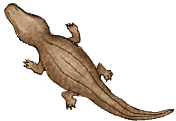| |
| Fauna : Estuarine |
| |
 |
IUCN Status :LOW RISK CITES : Appendix I |
Wildlife (Protection) Act 1972 : Schedule I |
Height: Males :6 - 7 mtrs (19.6 - 22.9 ft)
Females : 3.5 mtrs (11.8 ft)
|
|
|
|
|
Description
Along with the Gharial, the Salt water or Estuarine Crocodile (Crocodylus porosus), is the largest of all crocodiles in the world. A lighter shade of grey in colour, the snout appears quite slender and the ridges above the eyes are prominent.
|
 |
The most widely distributed of the world's crocodiles, they range from the east coast of India south to Sri Lanka, throughout South East Asia, Philippines, New Guinea to North Australia. Though best known for occupying brackish water habitats, they are also found in fresh water lagoons and estuaries and also occupy lakes and marshes inland. Salties have also been sighted in the open sea and swimming between islands. In India, they are primarily found in the Sundarbans Tiger Reserve in West Bengal, the Bhitarkanika Wildlife Sanctuary in Orissa and the Andaman and Nicobar Islands.
|
|
|
|
This crocodile is known to be very territorial. Primarily fish eaters, they are opportunistic and do feed on domestic and wild mammals. Much feared by humans mainly due to their unpredictable temperament, their presence near humans is scarcely welcomed and in places like the Bhitarkanika Sanctuary in Orissa, Forest Department officials are often called to catch and remove salt water crocodiles if it takes up residence near habitation. |
|
|
 |
| Females become mature when they attain of 2-2.5 m. Their nest building and egg laying is very different from that of the Gharial (Gavialis gangeticus) or the Mugger (Crocodylus palustris), since the female builds a large mound with leaves and sticks in which the 50 - 68 eggs are laid. The incubation period is around 90 days during which the female guards the nest very closely. She is also known to protect the young after they hatch. |
|
 |
Biswas 1977: Nesting behaviour of estuarine crocodile, C.porosus Schneider JBNHS 74(2) :361
Bustard H.R 1980: India's most endangered crocodile - will the saltwater crocodile survive ? Makara 2(1):2-3
Bustard H.R & Choudhury B.C. 1980: Long distance movement of a salt water crocodile (Crodcodylus porosus Schneider) Brit.J.Herpertol 6(3):87
Bustard H.R & Choudhury B.C. 1981: Conservation future of the saltwater crocodile (Crocodylus porosus Schneider) in India JBNHS 77(2) :201-214
Kar S.K. 1981: Studies on the saltwater crocodile, Crocodyle porosus Schneider. Utkal University, Orissa |
|